If
one wants to learn swimming the learner cannot start by jumping in unknown
water. If one wants to learn cooking one cannot start by learning preparation of
Mysore Pak made of almonds. Any subject that you want to learn can be gradually
proceeded with. The first day, one has to begin with writing “A” for Apple
only This also applies to education in Yoga. Our body is mainly divided into six
systems, like breathing system, blood circulating system etc. But bone system is
the supporting structure for all. For a house, if foundation is strong and if
terrace is well constructed so that no water leaks in the house, if these are
ensured , then it is allowable to proceed for good flooring, painting and
whitewash. New roof, good curtains and furniture can be provided but first and
foremost essential is that the basic structure should be strong. Bones make
structure of our body It is necessary to provide lubrication in all joints. Our
body structure of bones suffer from defects similar to those met with chain of a
cycle, bearings of swings, and aldrops of the the doors, if they are not
properly oiled. If electrical fans are not lubricated as desired it makes noise
and disturbing sound. Similar is the condition of the structure of the bones
of the body Flexibility exercises are to be practised before performing
Yogasanas. A practitioner of Yogasana helps various parts by flexibility
exercises. Various parts like thumbs of the legs, ankles, knees, thighs, and
joints of the backbone, shoulders, elbows, and wrists of hands, fingers and
palms, various backbones, chest, lungs, eyes, and finally intestines in the
belly including all glands which secrete juices, even if a practitioner of
Yogasana cannot do anything beyond the flexibility exercises even then treatment
of diseases get much support by such exercises.
METHOD
OF FLEXIBILITY EXERCISES
Sit
on a blanket, spread over a carpet for purposes of practising of Asanas.
1. Sit with legs
spread straight along the ground. While taking deep breath, simultaneously press
legs, thumbs and fingers forward You should release breath simultaneously
making the fingers relaxed. Every time you should press forward only thumbs and
fingers. No bending should occur on the soles of the feet, simultaneously take
deep breath in and out. Repeat this process 8 to 10 times.
|
|
2. Sit with legs
lying on the ground, straight. Keep the legs slightly apart. Keep a distance of
6 to 8 inches between two legs. Keep both the legs at some distance and press
the soles of both legs downwards while inhaling deeply Keep the soles pressed
forward for a period of counting ten. Repeat
this process 8 to 10 times. Thereafter in a manner that you pressed soles
forward, now bend and press in the reverse direction towards your body Repeat
this process 8 to 10 times. When we sit like this with legs spread along the
ground and when we press soles in the front and backwards we are stretching
muscles of the legs, knees and sciatica nerves situated under the thighs. This
exercise is found very helpful to those who get a pain in knees and sciatic
nerves.
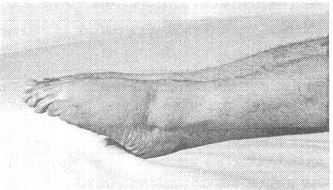 Fig. 2A |
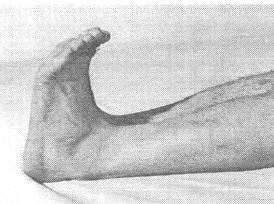 Fig. 2B
|
3. Sit with legs
spread out. Rotate the paws of feet on heel as a centre. Initially do this
clockwise and subsequently anti-clockwise. This exercise is advantageous for the
joints of the ankles.
4. Sit with legs spread out straight. Bend the right leg knee; raise the right leg to an angle of 90 degrees by supporting by both the hands and right thigh held up. In this raised position move the leg clockwise and anti-clockwise in circular motion 8 to 10 times. Repeat this process with left leg also. This exercise is very much helpful in pain observed in the cover bone of the knees. By regular practice one can save oneself from arthritis and joints pain.
|
|
5. We have to continue sitting with legs straight. Now keep the palms of the hands near your buttocks, spread on the ground and elbow should be used for support on the ground. You can first take support from right hand, thereafter on the left hand. In this position shoulder and head will remain lifted up. Lift the whole body, which is situated under the navel. We should then bend both the legs from knees and simulate running or cycling. This exercise is to be done in a vertical axis going round so that we get exercise on the knees.
|
|
6. In this exercise also one has to sit with legs stretched. Keep palms of hands quite near the buttocks and raise your whole body at 450 above the ground. Thereafter right from navel to the thumbs of both the legs, move your body in a circular motion, initially clockwise and thereafter anti-clockwise. This process gives a lot of exercise to intestines in the belly We go on eating in the morning, noon, evening and night whenever we feel like. The rule for eating is that one should not eat second time till food taken once is digested, but this discipline is not observed and hence we get gas and constipation as a result of food remaining undigested.
Our food contains oil, chillies and sourness in great proportions. It also includes garlic and onions in plenty, milk and curds are not included, exercise is not taken, there is no rule applying to consumption of food, the result is food gets putrified in the intestines, which results in chronic colitis. The exercise described above helps intestines. Our bowels therefore move easily hence even if one finds this exercise little difficult, even then it is of great use.
7.
Continue sitting with legs spread forward, keep the right hand at a little
distance of the back behind the body. Bend the body on the right keeping the
left hand on the opposite right side. This will bend the spinal column in a
manner that happens when wet cloth is twisted for draining out. This process
should be repeated both on right and left sides. When you are exercising on the
left side you should keep left palm of hand at a small distance from the body
Keep right hand on the opposite left side and twist the body There is no
supporting distance between last five vertebras. There are 33 vertebra in the
spinal column. One supporting disc is situated between the vertebra. The group of
five vertebras has triangular shape. Normally most of the people suffer pain
under the waist in these vertebra, collectively known as sacrum.
|
|
One
also gets pain in the upper part of the hump of the back. People also get pain in
the hump. It is essential that sufficient blood supply reaches between the discs
of the spinal column. This exercise provides, the blood supply
This exercise is also useful to perform ParshvaVakrasana, Vakrasana and Ardha-Matsyendrasana. By twisting the body on both right and left sides, fat collected on the lower side of abdomen decreases.
8. For this exercise also one has to sit with stretched legs. Close the two fists of the hands. Now imitate rowing a boat like a boatman rowing a boat by bending forward right upto the legs. Repeat this exercise 8 to 10 times.
|
|
This reduces collection of fat on the abdomen and its upper part also. Spinal column becomes more elastic. Here although body exercises more, less tiredness is felt.
9. So far exercises were performed with both the legs stretched forward together. Now sit with both the legs on the ground in the widespread position. Using the right hand, catch hold of thumb of the left leg. Take your left hand round the back side. Now bend forward with body twisted such that your head touches the left knee. This process should be repeated on both the sides 6 to 12 times.
|
|
10. Sit with both legs stretched and kept wide apart as much as possible. Stretch both the hands forward. Lock the fingers in the direction opposing the face. Now as if you are grinding wheat in a two wheel country type grinding machine move both the hands, keeping them absolutely straight and parallel to the ground, in a circular motion so that you can touch the toes of both the legs.
|
|
|
|
Ensure that both the legs are kept as wide apart as possible so that the circle described while working with the floor mill will be bigger. This process should be repeated both in clockwise and anti-clockwise directions. By the above 2 exercises nos. 9 and 10 elasticity of the spinal column improves. The fat on the belly decreases. It also massages internal glands situated in the belly That increases its working capacity Digestion improves, constipation reduces and hunger increases. The pain at the back gets relieved. The upper muscle part on hand gets strengthened. It also exercises thighs and leg muscles. Ladies feel improvement in ovaries.
11. Now sit in Vajrasana, sit with both legs bent from the knees keeping them twisted in the manner similar to the position used by Mohammedan friends when they sit for ‘Namaj’. Keep thumbs of the legs touching each other, keep the heels apart and sit on both the legs keeping buttocks in between the heels. Raise both the shoulders and leave both the hands straight and loose. Do not bend the elbows of the hands. Raise and lower the shoulders. Repeat this process 8 to 10 times. By this exercise and some of the exercises described hereafter the joints of the shoulder bones, which are fitted in the form of ball and socket joints get exercise. Generally socket is little bigger than the size of the ball, so that ball can fit inside the socket and easily move around. This is similar to our shirt and trousers being kept little bigger than the parts of our body It is well known that in comparison to the proportion of the size of the body, even tight fitting clothes are slightly bigger.
|
|
Normally
seed is always smaller than the fruit. However in this case of joints pertaining
to the shoulders this rule does not apply The bone of upper hand sits right up
in a triangular shaped cavity in a bone in that part of upper hand known as
humerous and the triangular bone is called a scapula where rounded top sits in
this joint is held
by ligaments and muscles. The condition of these joints is quite delicate in
comparison to the joint of the thighs between femurs and illum. The rounded head
of the femur fixes very well in the cavity of ilium. Hence if one runs or moves
his legs round above or up and down and takes different positions as in eastern
or western dances and special bent positions also, the joints do not get
displaced or dislocated. If suddenly some heavy weight is applied then the neck
of the ball shaped portion could break or get a crack. Even then it does not get
dislocated but this is not the case with humerous and dislocation of your hand
easily occurs. Bonesetter pushes this portion back into the cavity This is not
the case in bone pertaining to the joint of the heaps. Therefore the exercise of
moving shoulder up and down is very important though very simple.
12. Now get the body straight up between the buttocks and waist while you sit in Vajrasana. Thus one will have to stand up with the support of knee joint and two upper parts of the legs. The whole body will assume a shape of right angle. Now, keep both the hands right from the shoulder completely away from the chest and move round both the hands in opposite directions such that hands cross each other.
Both the hands must be moved round clockwise as well as anticlockwise. Repeat this exercise 10 to 16 times. This process which we performed by keeping hands parallel to the body and stretched away from the chest should now be performed by keeping both the hands on the side of the body in the line with both shoulders. You have to give clockwise and anti-clockwise movements. This process should also be repeated ten to sixteen times.
|
|
|
13.
Sit again in Vajrasana position. Breathe deeply. Simultaneously raise both the
hands right up along the head and press the palms of the hands on each other.
(see Fig. 11) Go on releasing the breath making no sound and continue to press
the hands. Lower down both the hands pressing each other to a position straight
opposite the chest, thereafter separate the two palms. Again take one deep
breath and raise both the hands. Press both the hands by each other and release
the breath, bringing the hands
|
|
14. If one cannot sit in Vajrasana this exercise can also be undertaken sitting in a chair. But sitting in Vajrasana allows great pressure to be applied on leg muscles and thighs. Hence circulation under the navel gets limited thereby making a very good effect on digestion, breathing system as well as genito - urinary system. Besides by position of Vajrasana more blood flows to the head. Pumping system of the heart feels less strain.
Sit in Vajrasana, keep both hands on shoulders. Keep both elbows up in the same plane. Thus both the shoulders will be in one line between the elbows. Continue to keep hands above the shoulders but move both elbows backward and forward. (see Fig. 12-A, 12-B) This exercise also simulates rowing and develops as well as strengthens neck bone, shoulders and chest.
15. Sit in Vajrasan. You can carry out this exercise in standing position also. Keep both the hands in line with shoulders parallel to the ground. Turn the palm of the hands from the facing position to the back position.
Keep both the hands upto the elbow quite straight. Let the lower hands hang from the elbows. Swing them like pendulum of the clock. Initially try to repeat this exercise 8-10 times. This will tire you out.
We will now discuss about the hand projecting below
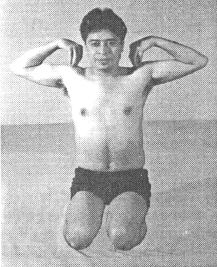 Fig. 12A |
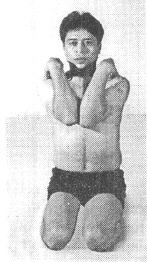 Fig. 12B |
the elbow, wrist, fingers, neck and cervical vertebra behind the neck. We shall also discuss butterfly exercise for those friends who find difficulty in sitting on the ground with crossed legs.
FLEXIBILITY
— 2
Our body needs food, sleep, cleaning of bowels. It should not remain lazy or sedentary but body should be active, energetic and full of vigour .For the entire life one should feel full and perfect; in a like manner, body also needs exercise.
We generally eat more than what is essential or enough. We drink comparatively less water. People hardly spend time in exercising. ‘We provide our homes with walker, bullworker or stationary cycle on seeing the advertisement, in the T.V. As if that is not enough many people use their basement in America to rig up a “GYM”. In Florida and Texas each house is provided with a swimming pool also but the swimming pool is hardly used for swimmers, only cleaner machine goes on cleaning it. It is painful to write that these days laughing clubs are required to be opened in many places. People gather in the parks and raise their hands and laugh artificially That is not a laugh. It is only simulation of laughter. Well, that is not wrong, but is it not a matter of laughter that one has to join a laughing club? This aspect brings laughter; is it not?
In olden times people used to go out in the jungle or outside the town for natural calls. Even interior places in the country now do not use this arrangement. Every room has attached bathroom and rest room, how much do you walk then? From the bedroom to bathroom or kitchen and to the garage! How do we then have a solution to the problems created with the body in one of the tours undertaken for training in health exercises, one fat lady came to see me. She said, ‘Swamiji, all the joints of my fingers are swollen. Please look at it.’ I asked, ‘How do you then prepare dough for the Chapati?’ She said ‘Why ask such irrelevant questions?’ I asked ‘What are the various items can you cook?’ She said ‘My Husband knows everything.’ I could offer only one prayer, ‘Oh God! Birth after birth, kindly oblige this sister to get the same husband over again!’
Now, in our country also, work-maid does the sweeping and mopping, clothes are washed in washing machine, ironing is done by washerman, cooking is carried out by mother-in-law, office peon brings the vegetables and my husband; Well, long may he live! The same work is done by peon as well as the husband! Then madam ‘What do you do?’ ‘Oh Swamiji, this house is a big one. One has to look after it.’ Very well mother, you look after the house and house will look after you! Go on looking after each other in this fashion! House is an inanimate thing. You will also become similar! If body is not applied for various jobs concerning the home, body turns lazy One goes on ordering the other ‘Get me some water.’ This may work for a while. But demand will ultimately go unheeded. However, if we carry out all household jobs ourselves, most of our health problems could be solved.
For sound health if the following six rules are observed, life will be more beautiful, happy and joyful.
1. Eat half the stomach full.
2. Drink water equaling double the quantity of food.
3. Take exercise three-fold.
4. Laugh four-fold.
5. Work five-fold the present quantum of jobs.
6.
Repeat Ram-nam six-fold.
7. Form a habit of laughing freely and loudly
16. Flexibility exercises are so designed that young or old, healthy or recuperating, even slightly sick persons can also perform these exercises without any fear.
In this series keep both hands opposite to each other at the height of chest as in case of two friends meeting and shaking hands. Keep a little distance from the chest and in front of the chest. Take a deep breath. Release the breath, while lowering hands. Again bring hands up to the level of the chest and then pull the hands in opposite direction and take a deepbreath. Bring both the hands down while releasing breath. This exercise should be repeated 8 to 10 times. Repeat the exercise with hand stretched behind the head also. When you do this exercise of pulling hand behind the head, see that you do not touch head. For relaxing, bring the hands over the head in front of chest and then relax.
|
|
17. (A) It will be helpful to continue to sit in Vajrasana as long as you can. If you cannot sit in Vajrasana, sit with folded legs or even on chair and perform the following exercises.
Stretch forward both your hands at level of chest. Bring your hands in the outer direction as if you are throwing them away very speedily Keep your fingers of the hands stretched as you are acting in horror movie. Keep the hands very stiff and slowly approach the chest. Let the fingers be kept as in a horror film position and throw again, draw again throwing in the front and bring it to back. Repeat this exercise 8 to 10 times.
|
|
(B) Now bring the hands straight in front of the chest, fold the hands from the elbows of the hands. Move both the hands in circular motion, clockwise and anti-clockwise, 8 to 10 times.
(C) Above exercise should be repeated 8 to 10 times with your fingers relaxed and separated.
(D) Keep the thumb inside the fist and close the fist. Open the fist. Now keep the thumb outside and close it. Again open it. Repeat this 8 to 10 times.
(E) Keep the palms of your hands facing each other at a distance of 6 to 8 inches stiffen, then relax. Repeat 8 to 10 times.
(F) Relax the hands beyond the wrist and make a movement as if throwing away something held in hands. Repeat 8 to 10 times. This relaxation exercise will give enough exercise to your elbow, palm and fingers.
18. The exercise now described is very helpful to the patient of cervical spondylosis. Those who perform this exercise regularly save themselves from the effect of cervical spondylosis. At this juncture one should try to understand what is meant by cervical spondylosis. We may not discuss this subject at present but may atleast understand that the top seven beads of vertebrae are known as cervical vertebra. When there is a pressure felt on fifth, sixth and seventh vertebrae some difficulties arise. This pain is known as cervical spondylosis.
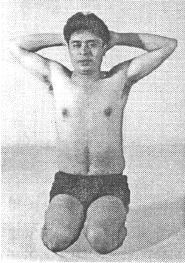 Fig. 15A |
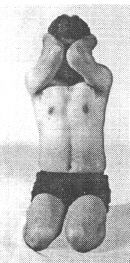 Fig. 15B |
Hold both the hands tight behind head. Relax; again tighten and again relax. Repeat this exercise 8 to 10 times.
19.
Bring the right hand down from the back side of head and then bring the left
hand, keeping at back side and take it up. Use the fingers of both hands as if
you are putting them in hooks, then pull both the hands, one down and other up.
Keep the upper elbow exactly in center of head. In front elevation it looks as
if a cow is lifting its head. The position of the legs in Gomukhasana pose is
different but hands are kept in this very fashion. Now repeat this exercise by
changing left hand in this position, left hand elbow must be under head. Try to
remain in both these positions. for one to one and a half minutes.
20.
Those who actually suffer from spondylosis will find it difficult even to sit
and stand up. Such people can use chair. However ordinarily this exercise should
be carried
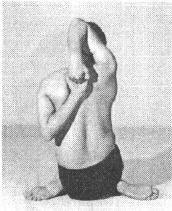 Fig. 16A |
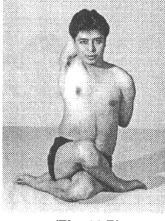 Fig. 16B |
Press the head towards the top by folded fist by keeping fist under the chin. Thereafter make a hook with the first finger, and hold the chin. Move the head up and down 8 to 10 times.
Now
move the head towards the right very very slowly
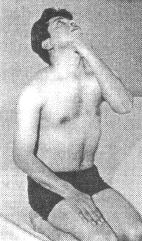 Fig. 17A |
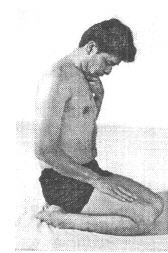 Fig. 17B |
|
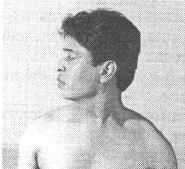 Fig. 17C |
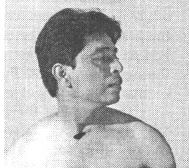 Fig. 17D |
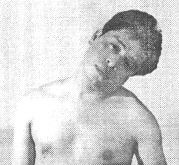 Fig. 17E |
Thereafter move it to the left, similarly without any haste or any jerk, repeat this exercise 8 to 10 times, in total, that is 4 to 5 times in left and right.
Thereafter bring the right ear up to the right shoulder and then the left ear to the left shoulder. This exercise should be repeated five times, inclusive of right and left side, totalling 8 to 10 times.
In the end the neck should be bent forward to the right, and move towards left, both in clock-wise and anti-clockwise directions. Repeat each side four times. All these exercises should be performed without any haste, peacefully and without any jerk.
21. After completing the exercise on the neck, come to the eyes. Normally we are flexing the eyes very much. We hardly give rest to the eyes. About 25 years ago India imported a rapid reading method from America. One of the main lesson in that method was to keep the book stationary while reading. In our country, we have a stand on which big books like Bhagwata, Ramayana, Geeta etc are supported. A similar stand made from wire was used here too.
The intention was clear. One has to keep book steady while reading. Eyes were to be shifted from the left when the line begins to the right straight along to the end. One had to move the eyes where the line ends across to where the next line begins. By such a procedure all the muscles of the eyes will get exercise.
The pupil of the eye is fixed by various muscles on left, right, above as well as below. If practice is carried out on all these muscles one can keep eyes sound, strong and quite capable.
We will discuss further about healthy eyes, hereafter. We may first get equipped with exercises for the eyes.
(1) Move the eyes in a vertical axis, both downward and upward. See that eyeballs as well as the pupils only do the movement. The head should not move.
(2) Move the eyes in the straight line from left to right and right to left.
(3) Move the eyes diagonally from right to left and from left to right.
(4) Move the eyes in a semi circle on the upper side from left to right and right to left.
(5) Move the eyes in the lower semi circle from right to left and left to right.
(6)
Turn the eyes round clockwise and anti-clockwise.
(7)
Stretch your right hand in the front. Bring the first finger slowly nearer and
nearer to the eyes. This will make the eyes in opposite angles near the cornea
of eyes.
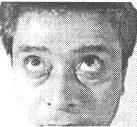 Fig. 18A |
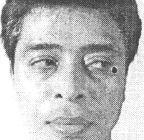 Fig. 18B |
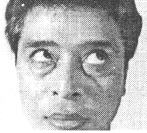 Fig. 18C |
In the earlier exercise of the eyes both eyes were moving in parallel line. In this exercise (Fig 18 A) eyes become eccentric hence sometimes you may see two fingers in place of one. This is as it should happen. One finger will be the main finger which is real and other will be an optical illusion. Move the right hand finger from nose to the farthest end of hand and then again from the farther end, bring nearer to the nose. Repeat this process four to six times.
(8) In the end close and open both the eyes very quickly 8 to 10 times. Thereafter rub both the palms of the hands so that they become warm. You may then put hollow of the hands on both the eyes. This process in called “Palming”.
NOTE: All these exercises of the eyes should be repeated 6 to 8 times. It is essential to rest the eyes. Keep them closed 10 to 15 seconds after each exercise.
22. There is a special importance attached to this exercise called butterfly exercise. Those people who are not accustomed to sit with legs on the around on Sukhasana find it difficult to sit even for a few seconds. Preliminary exercise for those who have arthritis, sciatica, pain of knees as well as pain while proceeding to sit in Padmasana.
|
|
|
|
|
|
(1) Sit down on the ground. Bend the legs from the knees in such a way that both heels and paws remain together and the legs remain opposite each other. This will allow both the knees to assume a shape of wings of a butterfly in opposite directions. Now hold both the paws at a time by both the hands and move the knees up and down like moving of wings of a butterfly Repeat this 16 to 32 times.
(2) Now release the hands from the paws of the legs as in earlier exercise. Hold both the knees by the hands above. Now move the knees up and down 16 to 32 times.
(3) Now stretch your right leg. Place left leg on your right thigh. Hold your left leg by right hand and your left knee by the left hand. Move the knee up and down 16 to 32 times. Thereafter move the knee clockwise and anti-clockwise 4 to 6 times in a circular motion.
(4) Now repeat process similar to above with left leg stretched. Hold the right leg by the right hand. Move the knee up and downl6 to 32 times. Thereafter move the knee clockwise and anti-clockwise 4 to 6 times in a circular motion
(5) Sit in Padmasana by keeping right leg on the left thigh and left leg on right thigh in such a manner that both the knees rest on the ground. If initially this is not possible, first put left leg on right thigh. Again repeat by putting right leg on the left thigh.
This
butterfly exercise is advantageous for both the joints of hips, joints of knees
as well as ankles. The working capacity of the legs increases because stiffness
of joints decreases. Ladies get a great advantage in the ovaries.
23. Sit with both legs straight forward. The two hands, must be kept on ground a little apart with fingers pointing towards the direction on back of head. Now raise the back as much as possible by balancing the body weight on both the hands, paws of both the feet and heels. The stiffness in the back will be reduced. This flexibility exercise will give you liveliness, sprightliness and will add to the vital air.
|
|
OM SHANTIH!
Latest Additions.........
|
Sivananda Yoga (Yoga DVD) Diwali Prasad booklet - "Kanakdhara Stotram" ( Sanskrit/ Gujarati/ English) Divya Jivan (Gujarati)/ "Amrut Putra" (Gujarati) Atam Mahek (Gujarati) / Fragrance ( English) - Swami Adhyatmananda |
Yoga, A Way of Life - Sri Swami Adhyatmananda
"Yoga and Health" - a complete book with Question & Answer section by Sri Swami Adhyatmananda
|
![]()
|
Please subscribe to Divyajivan Mailing List. We will update you with new uploads of spiritual literature on the web of Holy Master Sri Swami Sivanandaji Maharaj, saints of his lineage and other saints. We will also update you about the Sivananda Ashram, Ahmedabad website and facilitate communication with Sri Swami Adhyatmanandaji Maharaj. |
|
To manage your subscription, please visit Subscription Page. You can also subscribe and unsubscribe from this page. You may unsubscribe by yourself anytime you wish. You will be required to send confirmation link that you will get in your e-mail to complete this subscription. |
![]()